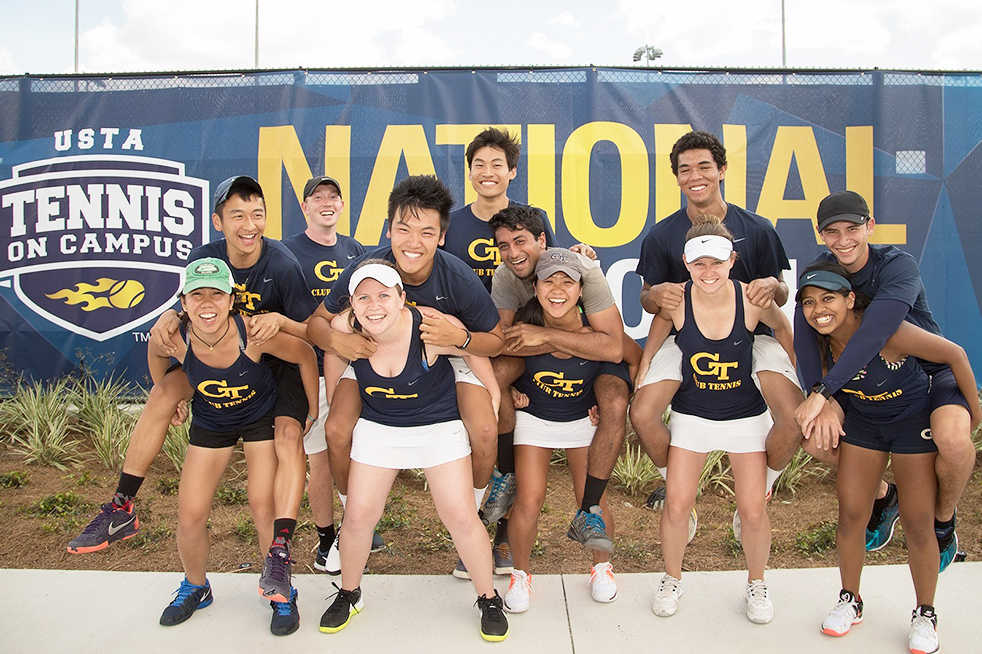It is easy to be sucked in by the year-round nature of college sports. There are March Madness and baseball in the spring, football in the fall, swimming and diving in the winter, and so many other sports on those seasonal lists. Every season is filled with excitement. Fans track statistics and trends, becoming attached to specific players and hoping that they move on to continue competing at the professional level. Collegiate athletes rise to the top of the social spectrum very quickly. It is easy to become a full-time spectator and begin to believe that those collegiate athletes can do something that you cannot.
While the likelihood of a collegiate tennis player going straight into the professional circuit right after college may be higher than the chance of a recreational tennis player jumping straight into an ATP World Tour, tennis fans should not forget that there are more tennis teams to support than just Tech’s NCAA-sanctioned collegiate teams. The Tech club tennis team has been working hard to become a consistent contender in club competition on the challenging national stage.
Tryouts are held twice a year for interested athletes. Though the tryout process for club tennis is less intense than recruiting for collegiate tennis, the levels of sportsmanship and devotion are just as high. Club tennis players approach the game seriously, striving not only to maintain fitness levels but also to win incredibly close matches.
Hard work and grit has paid off this year. Out of more than 700 college teams across the nation, Tech was named to a list of the top 64 co-ed intramural and club tennis teams by the United States Tennis Association (USTA). They competed last week at the 2017 USTA Tennis on Campus National Championship in Orlando, Florida with a chance to take home a national title.
Welcoming several new freshmen and sophomores to their ranks, there was some expectation of growing pains. Yet it seems that new talent has had the opposite effect for the team. These players have often made the difference.
“Our team’s drive to win the close matches against consistently great teams such as UGA and the University of Florida has helped the team be so competitive,” team captain Jake Inderrieden explained. “We are also fortunate to have a very young team composed of several freshmen and sophomores who have made an immediate impact.”
A focus on winning close matches carried the Jackets through the USTA Tennis on Campus National Championship and earned them first place in Pool P as well as a spot to compete in the Gold Bracket. The team won every match in its pool. Kicking off the weekend against Colorado State University, the Jackets quickly moved past the Rams, beating them by more than ten points.
As the day went on, Tech lost a little bit of its edge, but that didn’t keep them from defeating the University of Southern California and the University of Illinois on the court. The margin of victory in their final two matches may have been a little smaller than the first match of the day, but a win is a win, no matter how close the final score.
Tech moved on to compete in the Gold Bracket, and their diminishing edge moved on with them until it was no more. Losing to the University of Michigan in the quarterfinals, the Jackets closed the championships at eighth place. Although the team was not able to secure a championship title this year, the growth and dedication that have been developed has set them up to be future national competitors.
Winning is not Tech’s club tennis team’s only goal. If every individual is focused solely on securing a game for himself or herself, it would not be likely that the team would go very far, even in a sport like tennis where athletes often compete by themselves. The team aspect is just as important as being competitive and winning matches. In fact, it may even be more important. Supportive teammates make for consistently successful athletes.
“A good team captain is able to bring the team together to achieve more than each player could individually and motivate the team to perform better than every expectation,” Inderrieden said.
Inderrieden has done just that, and the results have reflected his team’s hard work.
